As aptly summed up by air racing pioneer and three-time winner of the Thompson Trophy, Roscoe Turner: “There is no excuse for an airplane unless it will fly fast.” The SX300 does all that and then some. Heck, it looks blazingly fast just sitting on the ramp!
Designed by Ed Swearingen, whose career and accomplishments can (and do) fill books, the SX300 was his foray into homebuilt aircraft. A self-described “eighth grade dropout” and self-taught engineer, Swearingen’s life was filled with incredibly innovative achievements. While perhaps best known for the Merlin and Metroliner aircraft series, he was also the first to utilize exhaust gas temperature (EGT) as an indicator of fuel consumption in reciprocating engines. Over the years he worked with such luminaries at Bill Lear, Dee Howard and Wernher von Braun, not to mention most of the leading aircraft manufacturers.
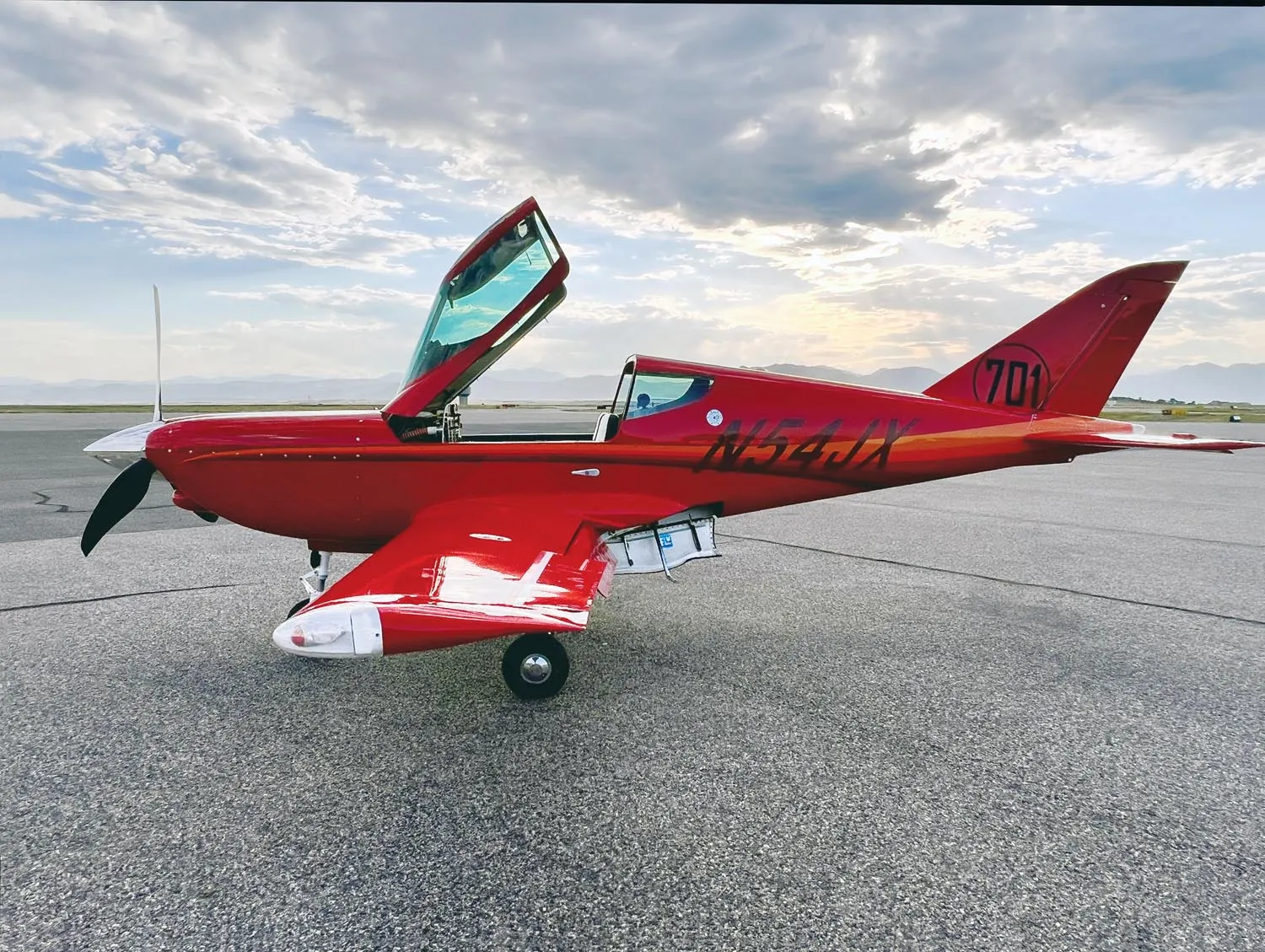
In 1982, Swearingen started a new company to develop a progressive design for small aircraft. He described this new venture in an interview: “What caused me to make the decision to start building airplanes again was the fact that single-engine airplanes had been flying at the same speeds since the 1930s. I thought, since they’ve had the same speed all this time, why don’t I aspire to build an airplane with the same engines for the same cost as a Cessna that flies 100 mph faster?”
Over the next several years he created the SX300, which was marketed and available as a kit aircraft from 1984–89. The ultimate goal was that the kit would lead to a “bootstrap” approach by creating the fabrication infrastructure and following it with production aircraft. That didn’t work out, but it did create one of the sharpest aviation hot rods the kit market has seen.
Beginnings
The SX300 began life in 1983 as the S29-300. The S was for Swearingen, the 29 denoted that it was the 29th aircraft design he created and the 300 indicated that a 300-hp Lycoming was mounted up front. Even though it was born at a time when composite construction was gaining more traction, the decision was made for it to be constructed from traditional materials. However, the goal was to make it as smooth as composite and to keep drag to a minimum.
With that goal in mind, the wing skins are thicker than average with mostly 0.040-inch aluminum being used. All joints are butted rather than lapped and have all countersunk rivets. The leading edges are stretch-formed over accurate dies and wrapped around the entire front half of the wing.
The powerplant, an IO-540, is behind a 74-inch, three-blade prop with a 7.25-inch extension. The cowl is composite and was based upon the low-drag cowl Swearingen developed for the Twin Comanche in the early 1960s, with evolutionary upgrades. The engine itself is offset 2° to the right and 1.5° down to account for P-factor.
The wing is small, no two ways about it. Reminiscent of the Metroliner, the high-aspect-ratio planform is best suited for climb and cruise efficiency. The airfoil was created by Dan Somer of NASA to maximize the positive features of laminar flow airfoils yet enhance the capabilities at lower speeds and be unaffected by contaminants such as rain.
The flaps take up a large amount of the wing chord to balance landing and takeoff capabilities. The wing loading is certainly higher than the average general aviation aircraft at 33.9 pounds per square foot, which makes for a nice ride through the bumps but higher speeds when landing or taking off. It is designed with a “wet wing,” where the wing itself functions as the fuel tank. Each wing holds 30 gallons of fuel. The tail feathers have a similar structure but the skins are thinner, 0.020-inch, and the leading edges are reinforced and stiffened with foam.
The fuselage has hydroformed framing members that are secured with the stringers and then the skins are riveted in place. Four skins come together to form the tail section, while flush riveting and butt joints give the appearance of having compound curves. The spaceship-like forward hinged canopy, with its wraparound windshield, is held in place with six plunger latches that are released with the turn of a handle. As every builder has discovered, hand-forming the compound-curve canopy sills is quite challenging.
The retractable landing gear mains fold back behind two doors, making them fully faired during flight. Each main gear has two doors: a large one for the wheel and a smaller one for the strut. A step is built into the smaller rear door and retracts with it. The nose gear wheel well bumps up into the forward cabin, but it is not intrusive.
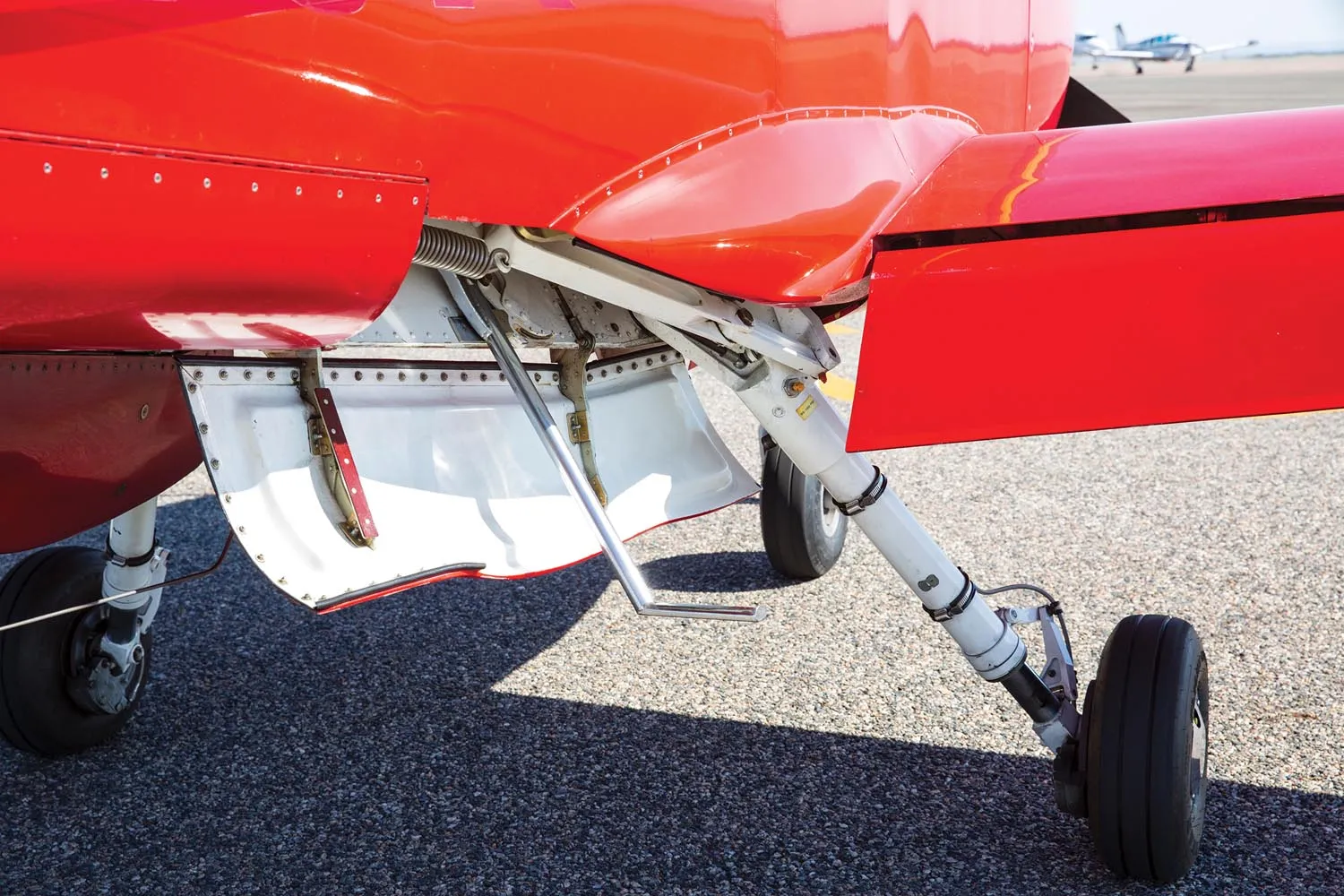
From an aeronautical standpoint, the design development focused on balancing the flight characteristics with performance. Given the speed range that the SX300 operates at, great care was taken to harmonize the controls and make it a nice-flying aircraft. The wings have a 3° twist to soften the stall characteristics. The ailerons have differential travel to diminish adverse yaw. The control systems are counterweighted and mounted on ball bearings, giving them a very smooth feel. The wing is tapered, but the leading edge remains straight, giving it both a straightforward stall and also a shorter moment arm to allow for different engines (with different weights) to be utilized. The airframe is stressed to +6/-3 Gs. During power-on stalls it flies into the buffet and gives a nice aerodynamic warning. However, with gear and flaps down it tends to break with less warning. Overall, the control system feedback is well coordinated, and with the high wing loading it is a very stable aircraft.
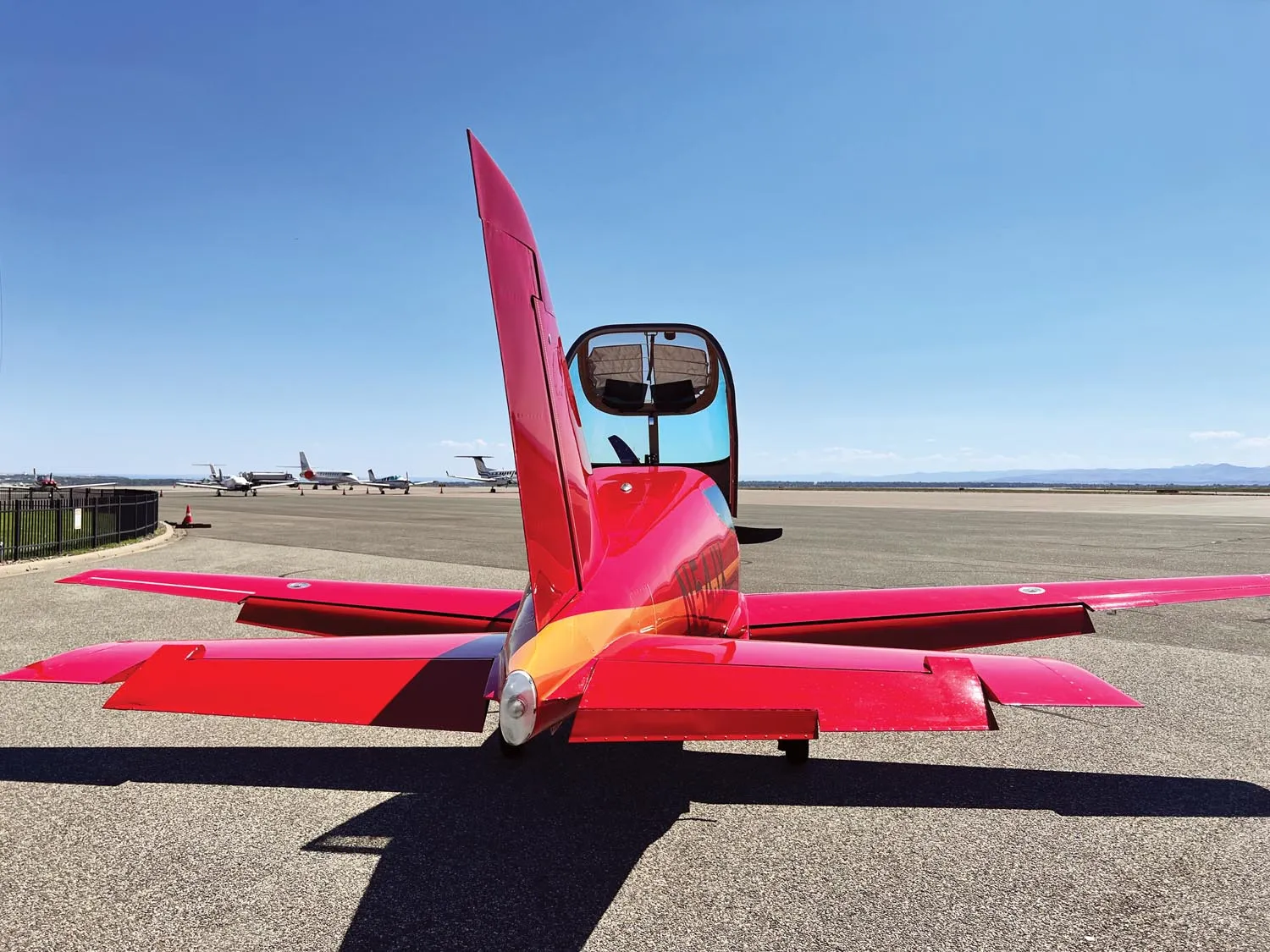
About The Kit
The SX300 officially started selling in 1986 as a series of subkits. However, sales ceased in 1989 as Swearingen switched to other projects and decided against pursuing a certificated version. There are a few reasons why production ceased. There was the official explanation that the stepping stone progress to make it a production aircraft wasn’t progressing as rapidly as the company would like. The more likely reason is that a turboprop prototype shed its wings, leading to a fatal accident during a demonstration, which ultimately diminished the interest of the military.
As far as kits go, it was a complicated and time-consuming build. Even for experienced builders, it was difficult to take a kit to completion. The detail work was not for the novice builder and some lost interest, especially when it came to some of the trickier bits such as getting the canopy to fit perfectly.
The production run for kits officially ended in 1989. Approximately 80–90 kits were sold. However, there were only 48 sets of landing gear (made by Airight LLC) completed. It is estimated that 45 SX300s were built to completion. Numerous kits have changed hands several times and languished over the years.
In 1994, Jim Ryan, who owned Airight LLC, acquired the tooling, kit components and production/manufacturing rights, with the goal of supporting and continuing the design. Unfortunately, he passed away in 1996 before his plans could come together. The inventory of parts was then acquired by Bill Johns and now resides with Doug Poli, both of whom run and support the SX300 group organization and website, www.sx300group.org.
N54JX
N54JX is the sexy red SX300 featured in this article. It was the second SX300 built by Bill Johns and was registered in 1999 as a Johns SA29, as a nod to the Swearingen company’s original designation. He sold it in 2009 to Florida-based Swiss airline pilot Heinz Peier, who upgraded the avionics and panel and then proceeded to have a number of adventures flying it around the world between 2012 and 2015.
Heinz added a 26-gallon auxiliary tank in the baggage compartment, as well as a 45-gallon tank in the passenger seat. With just himself and his folding bicycle, he visited something like 40 countries in North and South America, Europe, Africa, the Middle East, Asia and Australia. He also holds a unique distinction of being forced to land by the Malaysian air force a month after Malaysia Airlines Flight 370 went missing in 2014. They felt he didn’t have the proper paperwork to overfly their territory on his way between Sri Lanka and Singapore.
Needless to say, at that time the Malays were very sensitive about their airspace. Heinz had to withdraw the maximum daily amount from ATMs for over a week to accumulate the necessary cash to pay a fine before he could continue on his journey. For those who are interested, the Kathryn’s Report of this incident makes for entertaining reading. In 2016, Heinz was unfortunately struck by a drunk driver, curtailing his traveling. Although he recovered, he realized his globe-trotting days were over.

In 2021, Heinz put his SX300 up for sale. After serious consideration, Doug Eastman of Colorado wound up purchasing it in February 2022. A fellow airline pilot, Doug had been racing his Hiperbipe in the annual AirVenture Cup Race but was looking for something faster. He was considering a Glasair III or a Lancair Legacy to scratch the itch.
After talking with fellow AirVenture Cup pilots, Doug started eyeing the SX300. Doug isn’t exactly short at 6 feet 3 inches tall, and the interior dimensions of the fast-glass planes were downright snug for him. Conversely, the interior of the Swearingen allowed for more open space forward of the spar, making it comfortable for someone his size. After striking a deal and signing the papers for N54JX, the flight home to Denver from Florida took only 6.9 hours, cruising at around 260 knots. It took much longer than the flight home to get the smile off Doug’s face. Since its arrival to his hangar in Denver, he’s been exploring the envelope and getting used to it.
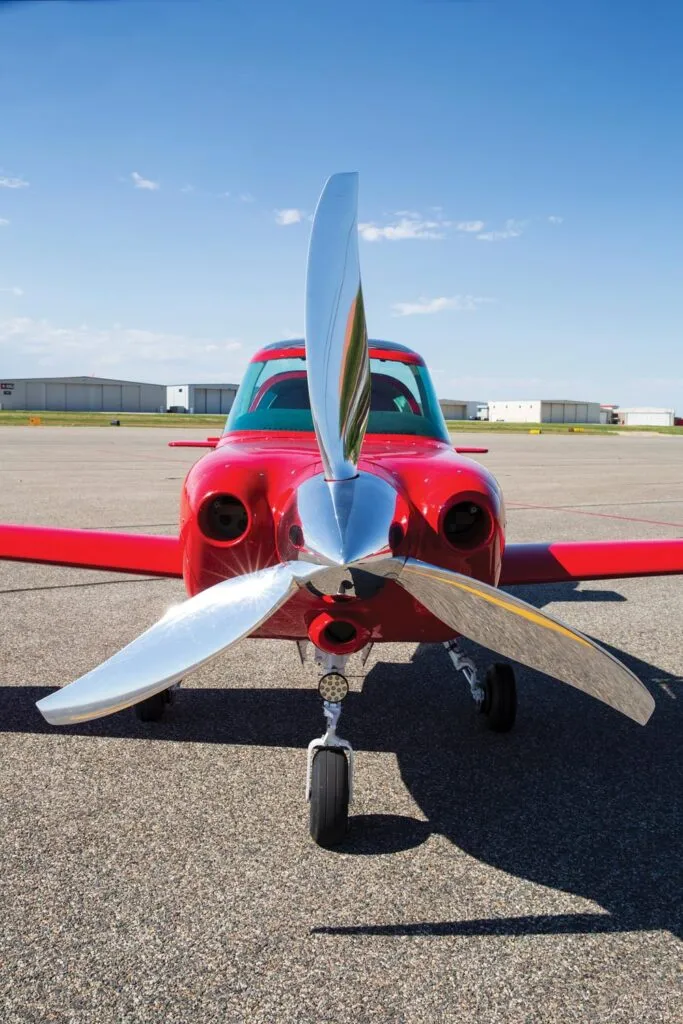
N54JX originally had traditional square air inlets but was eventually modified to round “LoPresti style” inlets and RAM air intake. It has a direct air inlet, where the ram air bypasses the inline K&N filter and adds another 1.5 inches of manifold pressure. This provides filtered air on the ground or when desired (such as flying in smoke), but with unfiltered air the plane gets 75% power up to around 9500 feet.
With a Vne of 280 knots, it is a fast cruiser. Flying from Denver to Oshkosh for AirVenture, Doug made the 774 nautical-mile trip in just 3 hours and 15 minutes, including a fuel stop! “Door-to-door, it’s faster than the airlines for trips under 1000 miles,” says Doug. Conversely, it slows down nicely when you use the big three-blade Hartzell prop up front as a speed brake. “I can come into the airspace at 240 knots, slow to gear extension speed by downwind and be turning final with 90 knots over the fence with no issues.”
With 66 gallons of usable fuel on board and a fuel burn of 20 gallons per hour, it has a very comfortable 700- to 800-mile range. Slowing to economy cruise, it burns 14–15 gallons per hour while still maintaining around 250 mph. We can only image how many pilots would love to have those “economy” cruise numbers. While these are turboprop performance numbers, remember it still is a piston airplane and doesn’t need to fly in the flight levels. On the way home from Oshkosh, Doug had the advantage of being able to stay low and avoid the headwinds while traveling west. So much so that he beat a friend’s Cessna Citation traveling the same route by an hour.
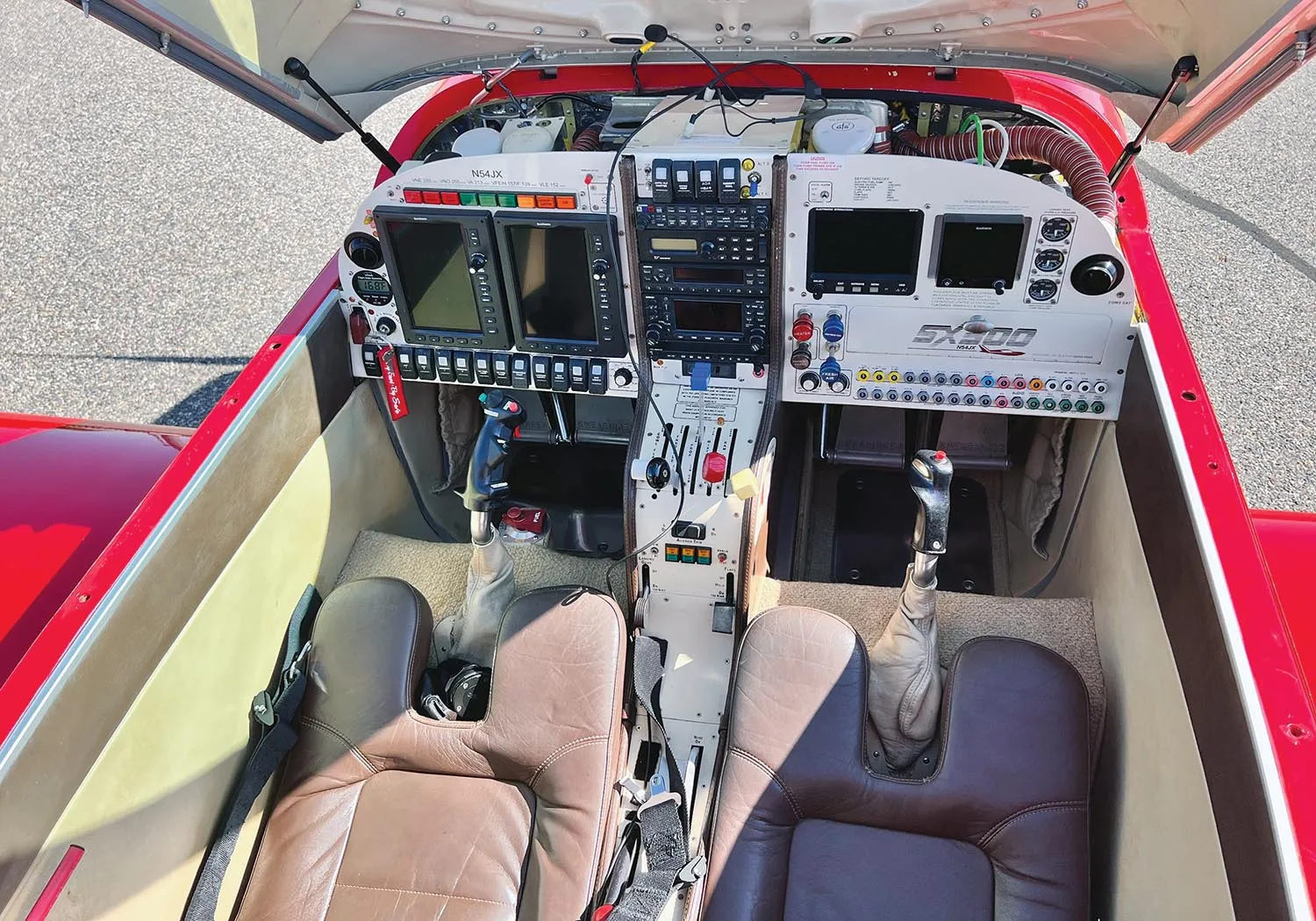
Going For A Ride
The author had the pleasure and opportunity of joining Doug for a flight in his aerial sports car. While a formal pilot report is outside our expertise, it certainly left an impression! Walking up to SX300, it reminds one of a Formula One race car or a low sleek super car, rather than one of the more mundane high-performance roadsters. Climbing aboard is easy and straightforward, and the canopy seats and locks in place like a fighter. Visibility is excellent, although clearly the overhead visor is needed because you could cook under all that clear plexiglass. The cockpit is roomy and quite comfortable.
Taxiing was straightforward and—no surprise—on takeoff the SX300 accelerates rapidly. With two adults and full fuel we were pushing gross weight, yet on a 99° day while taking off at Rocky Mountain Metropolitan Airport (KBJC), at an elevation of 5673 feet, we were cruise-climbing comfortably at around 1500 fpm. Popping up to 14,000 feet, we settled into a comfortable cross-country going up and over toward Steamboat Springs, Colorado (KSBS), then Cheyenne, Wyoming (KCYS), and back to KBJC, which is about 15 miles northwest of Denver.
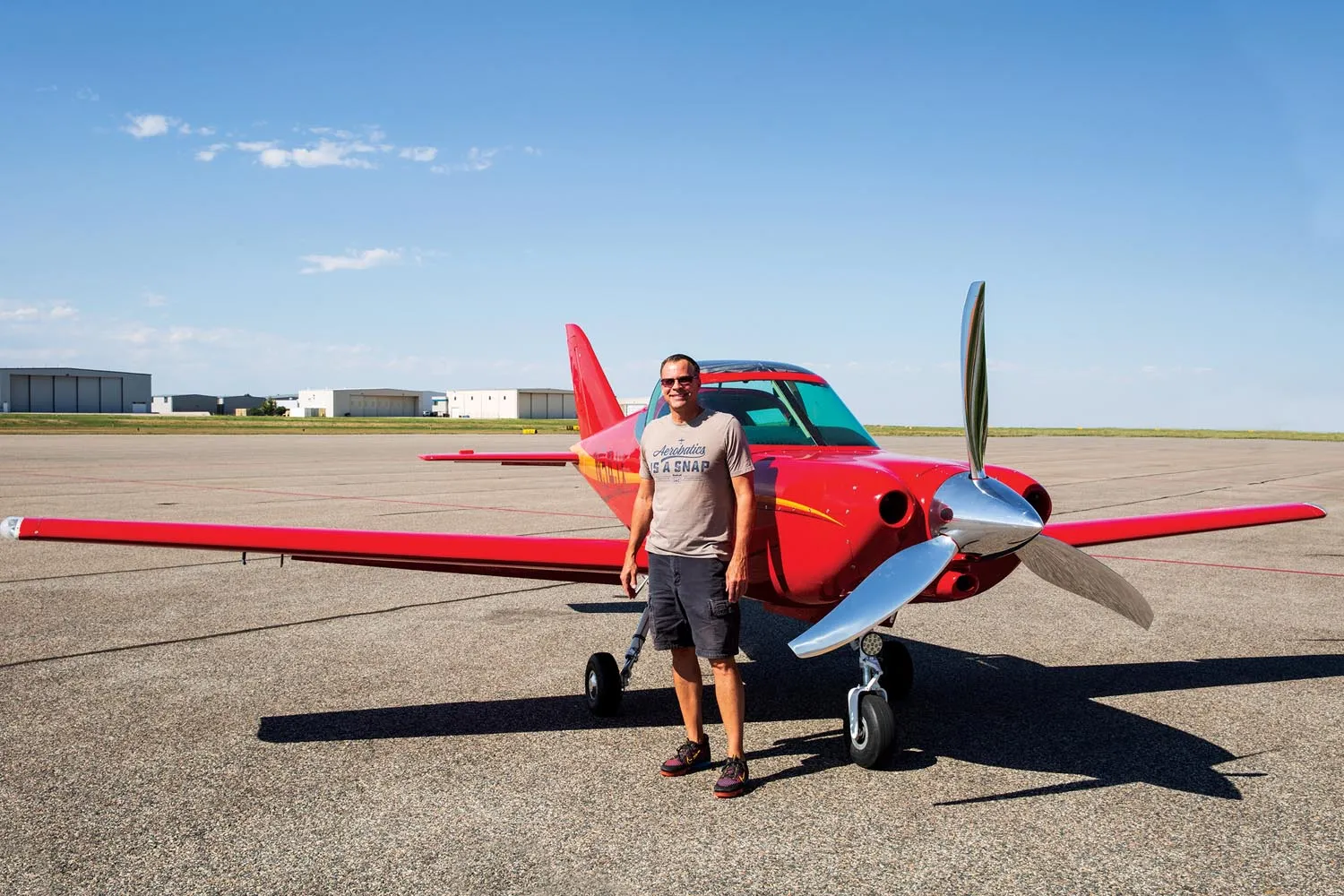
This tour was right around 260 nautical miles and didn’t take much time at all—just over an hour wheels-up to wheels-down. You can pretty much guarantee convective activity over the Rockies in the summer, and a flight in these conditions would normally be loosening your fillings, but with the SX300’s high wing loading, the turbulence was reduced to minimal chop. The controls were nice and responsive without being twitchy. Too soon we were back in the pattern for an overhead break to landing.
A few months earlier I had flown the same route in a turboprop Bonanza conversion, which while more sedate and genteel was significantly slower. Hands down the SX300 was far more fun to fly. On our little afternoon spin, we averaged around 300 mph. At those speeds the world shrinks and you start looking ahead to trips that are now in range. That being said, this is clearly an aircraft that requires some serious piloting skills. Staying current is a must because the SX300 is intolerant of any incapacity.
Keep ’Em Flying
As mentioned, of the original 80–90 kits, around 45 have been built. Thirty of those are believed to be still flying, including one in South Africa. One was placed in the EAA Museum last summer and presumably won’t be flown, so technically 29 are flying. Of those, 28 are insured by the same company. However, the cost to insure one to race at Reno ranges from prohibitive to impossible. When Doug bought his SX300 he toyed with the idea of racing there, but that dream has been put aside…at least for now.
Of the 45 that were completed, there have been a disproportionate number of accidents. Given its fast speeds and high wing loading, that is not surprising. Searching the NTSB database shows at least seven fatal accidents. Some of these were related to unporting of the fuel when fuel levels got too low. N54JX has low-pressure fuel pumps that prime a high-pressure fuel pump to avoid this issue.
Landing gear trunnion failures have claimed at least another five aircraft (airframes with 500+ flight hours) when one of the main landing gear struts failed to lock down. The nose gear keeps the prop off the ground but the affected side drags that wingtip. Fortunately, this seems to have caused relatively limited damage to these aircraft and has not proven to be fatal. However, this brings up a significant concern for owners: How do you find parts for such a unique aircraft? Well, the SX300 Group has a “parts pool” that members can buy into, limiting some of the critical parts shortages. Any prospective SX300 owner would do well and is strongly urged to become part of this organization.
This brings us to an interesting question: What is the official designation? It has been listed as SX300, SX-300 and SX 300. Per the official logo, it’s SX300 without any dashes or spaces. But then again, it’s an Experimental aircraft so the builder can name it whatever they like.
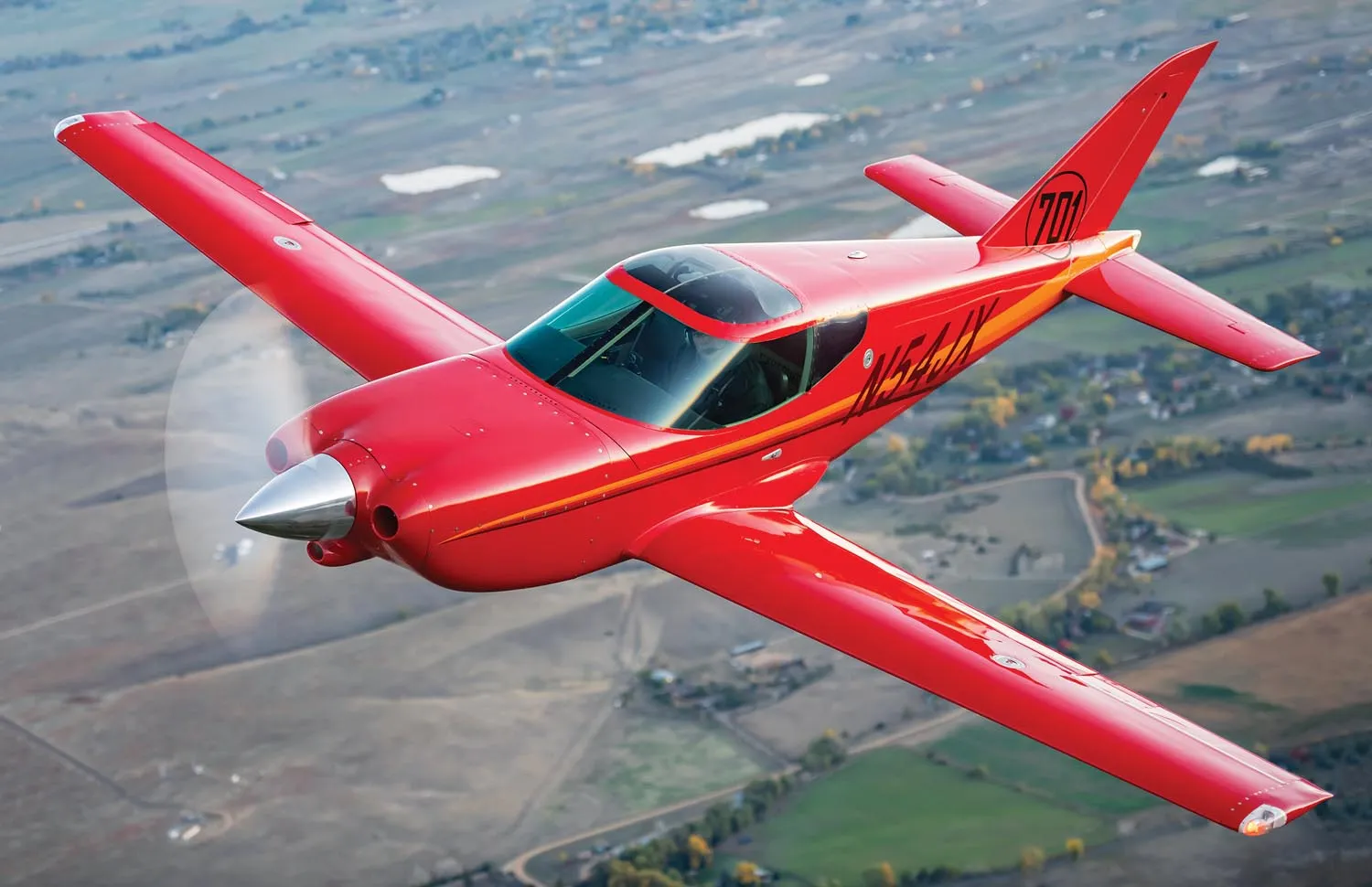
Ed Swearingen’s philosophy was “to know people who are the best at what they do and get advice when I need it. The other side of the coin is to set standards that are hard as hell to meet. When I decide to start something, I set standards and objectives that I know are questionable. But if I set the bar lower, I won’t do better. If I set goals that are almost out of sight, I may not make all of them, but the ones I do achieve will add up pretty good.”
The SX300 doesn’t just look like a thoroughbred rocket ship of an aircraft—it really is. We would have to say this aircraft is certainly one of Swearingen’s finest achievements.
Photos: Jonathan and Julia Apfelbaum.
Swearingen SX300
FIREWALL FORWARD
- Engine Lycoming: IO-540-L1C-5
- Horsepower: 300
- Power loading: 0.8 lb/hp
- Propeller: Hartzell constant speed
AIRFRAME
- Length: 21 ft 1.5 in
- Wingspan: 24 ft 4.5 in
- Wing loading: 33.9 lb/sq ft
- Fuel capacity: 66 gal
- Maximum gross weight: 2400 lb
- Typical empty weight: 1600 lb
- Typical useful load: 800 lb
- Full-fuel payload: 404 lb
- Seating capacity: 2
- Cabin width: 41 in
- Baggage capacity: 70 lb
PERFORMANCE
- Cruise speed: 240 kt
- Never exceed speed: 280 kt
- Maximum rate of climb: 2400 fpm
- Stall speed (landing configuration): 75 kt
- Load factor: +6G/-3G
This article originally appeared in the May 2023 issue of KITPLANES.
For more great content like this, subscribe to KITPLANES!



































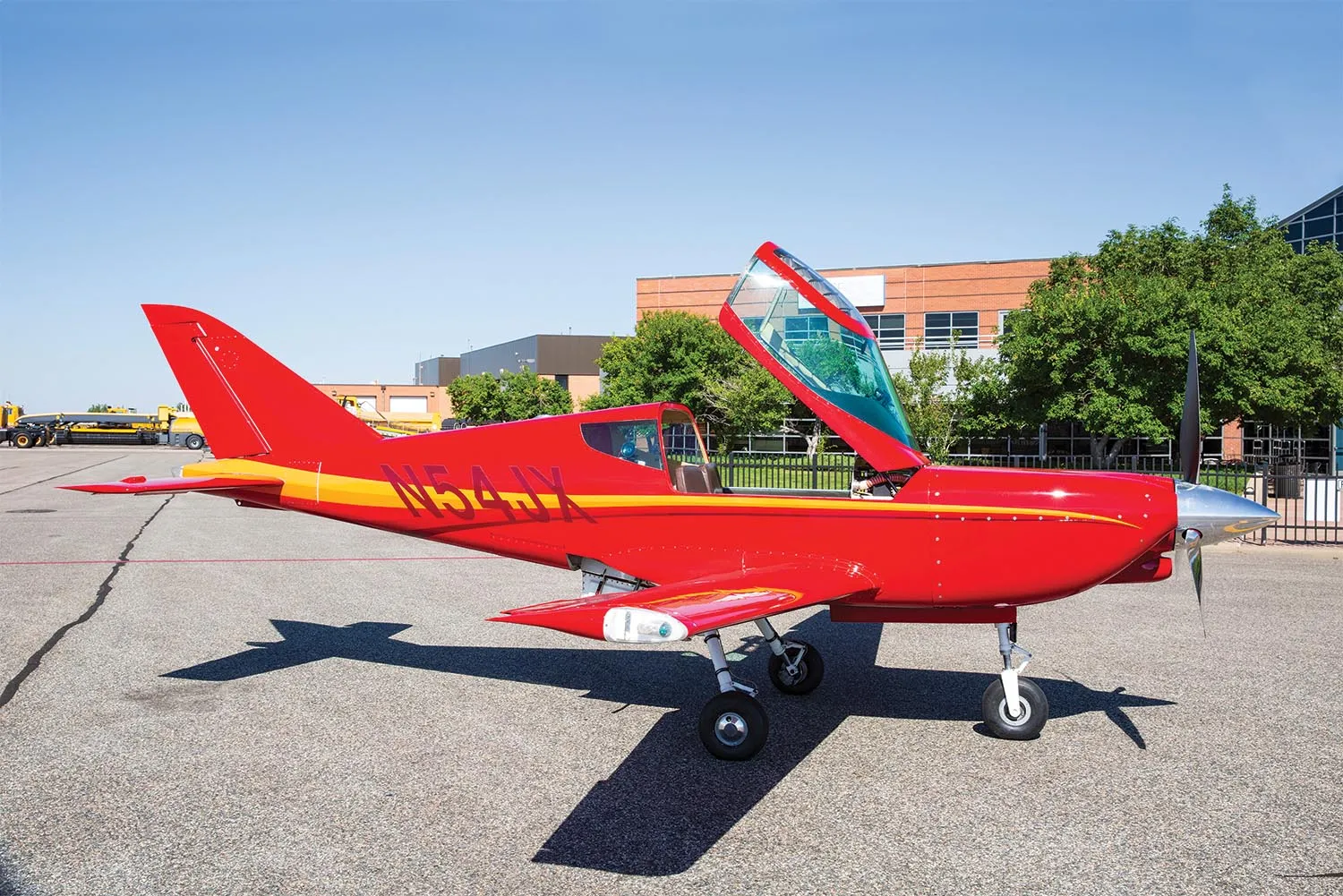


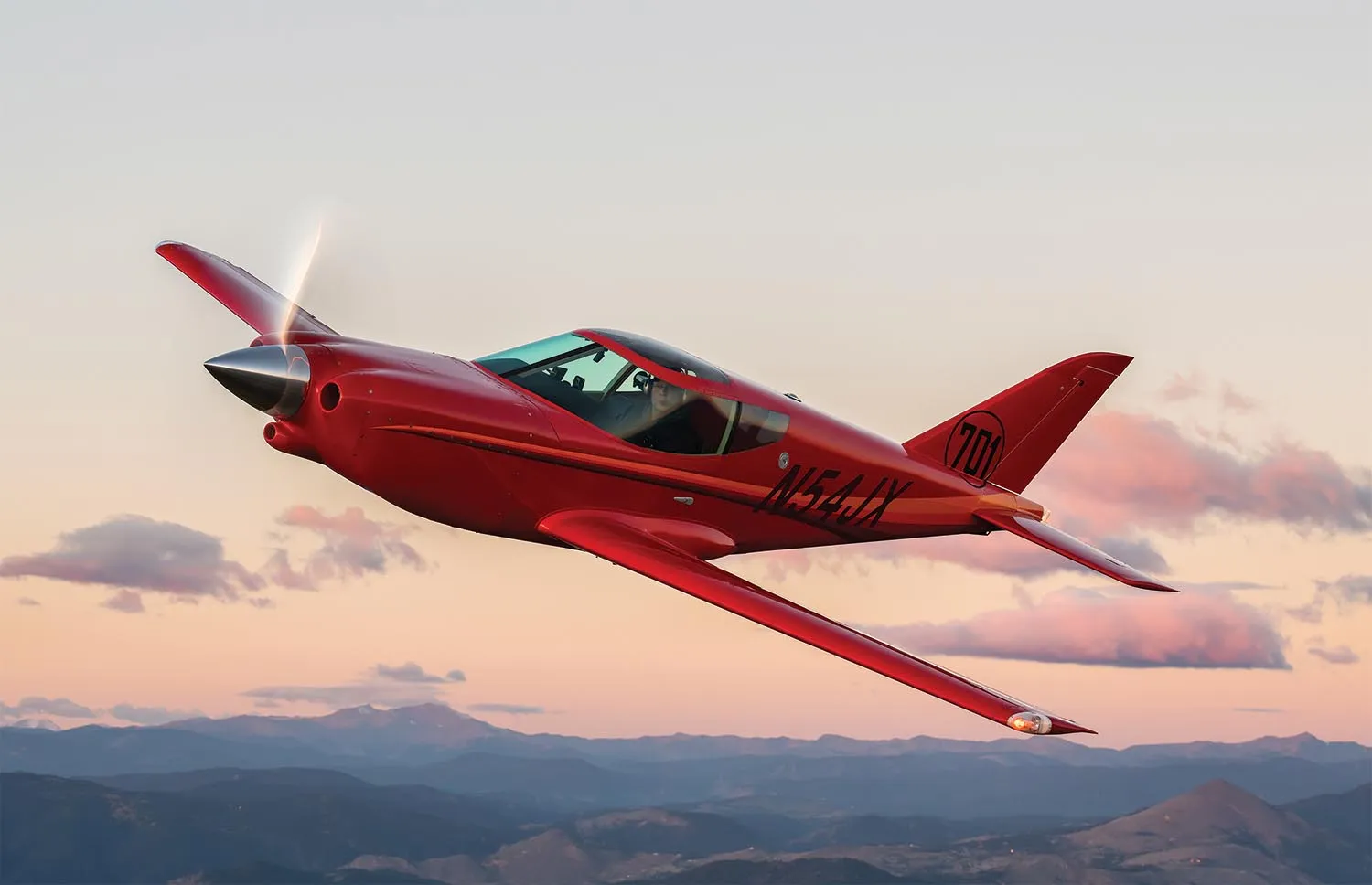

Every month our local EAA Chapter puts on a well-attended breakfast event @ X21.
Often a gaggle of SX300s will arrive, from Spruce Creek Airport, in tight formation, smoke on, overhead break. Hmm . . . pedaling as hard as I could in my Piper J-3 and an SX300 on the ragged edge of a stall . . . formation flight might just barely be possible?
I got a ride in one from a friend at Spruce Creek. Just for fun, I punched in Direct to my local airport in NJ. It showed under 4 hours from Daytona. My question to him was, why the hell are we not seeing you more often?
I would love to see a pt 23 version in production. I think they would sell like hotcakes.
Great looking airplane. It would be interesting to see it done in all composite and possibly get a little more fuel capacity. A big, thirsty IO-540 can go through 60 gallons of fuel pretty fast. As far as a production airplane, it would likely cost well north of $1 million. Ed Swearingen certainly came up with some interesting designs.